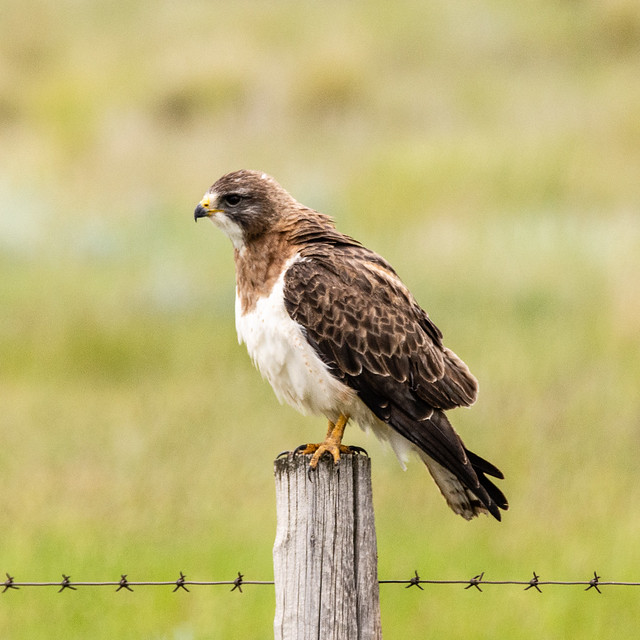Saskatchewan’s grasslands are home to a wide variety of species. It’s human nature to focus on the mammals, but there are thousands of other species – from bacteria and lichens to grasshoppers, snakes, ground squirrels, and coyotes. “It’s like going to the movies,” says Greg Fenty, coordinator, Saskatoon Young Naturalists. “We always focus on the movie stars and yet there are 7 minutes of credits. Without those people, Daniel Craig couldn’t jump from building to building. Everything is dependent on each other.”
Habitat Adaptation
Plants and animals can only live in a specific area, such as grasslands, if it meets their requirements for life – food, water, air, and shelter. “Animals must feel safe enough to reproduce,” Greg says. “If those basic conditions are met, the animals can often adapt to changes in their environment.”
Greg studied hawks with Stuart Houston, and it opened his eyes to why animals migrate. “It’s not about temperature,” Greg says. “The main driving factor is food. Richardson’s ground squirrels hibernate in the winter so the hawks head south to Argentina where they feed on grasshoppers until winter arrives in the southern hemisphere and they head back north.” What’s particularly surprising is how much the birds’ behaviour changes with the habitat. In Canada, they are solitary hunters, whereas in Argentina they congregate in large flocks to munch on grasshoppers. It’s all about adapting to the environment.
Evolution has played a big role in establishing a habitat that supports life. Greg says the prairie grasslands are “chock-a-block full of flowers – as many as an alpine meadow and you don’t have to climb 2000 meters to see them.” But the plants don’t all flower at once. Instead, they follow one another, providing food for pollinators over an extended period. “The crocuses are one of the first to flower in the spring, just when lots of insects are coming out of hibernation,” Greg explains. “Next is golden bean, and in the fall there’s goldenrod.”
Fruit-bearing plants are similar with Saskatoon berries ripening first, followed by chokecherries, and then buffalo berries. There’s always something for berry eaters to eat.
Wild Neighbours
Grassland plants and animals cannot survive in isolation. In fact, at times, coexistence can upset the normal predator-prey relationship. Prairie dogs nest underground for protection from predators, such as snakes. However, snakes will use the prairie dog burrows when they need a spot below the frost line to hibernate.
Prairie dogs are a keystone species supporting over 130 other species. If they are wiped out, it sets off a whole chain of events affecting the whole ecosystem: "In addition to serving as a food source for coyotes, eagles, the endangered black-footed ferret, and other animals, they are ecosystem engineers, maintaining the health of arid grasslands by churning, aerating, and fertilizing soil as they create vast and intricate underground colonies. Their digging allows an array of vegetation to thrive, which in turn supports a greater number of elk, bison, and other grazers. And their burrows provide shelter for animals like rattlesnakes, burrowing owls, and jackrabbits. When prairie dogs disappear from their native grasslands habitat, woody plants can take over, fundamentally altering the prairie ecosystem." (Keystone Species 101)
Animals tend to become specialists in hunting specific species. Black-footed ferrets and swift fox don’t wander far from the prairie dog range, while Swainson’s, red-tailed, and ferruginous hawks’ territory overlaps almost exactly with that of Richardson’s ground squirrels. “The timing is ideal,” Greg says. “The hawklets are learning to hunt just when the naïve, goofy young ground squirrels are coming out of their burrows – a perfect opportunity for the young hawks to hone their hunting skills.”
Cougars used to be much more plentiful, but that situation changed as more and more people moved onto the prairies. “Humans and big cats don’t get along because humans are potential prey,” Greg explains. The cougars were almost wiped out from most agricultural areas, and remote areas such as the Cypress Hills uplands or Moose Mountain became refuges for cougars that were shot if they ventured out. Greg says the situation began to change during the first and second world wars as lots of young men left and there was an ammunition shortage. “The white-tailed deer got a really good foothold, their numbers increasing dramatically in the late ‘40s,” Greg says. “Cougars love to eat white-tailed deer so cougar numbers increased and they were forced to out-migrate to find food. Now we’re seeing more cougars along the Saskatchewan River valley and north of Cypress Hills.”
Habitat Is Everything
The complex relationships between species and their multiple adaptations to their shared habitat are impossible to reproduce. “We can try and restore an area, such as a wetland, but it’s guesswork,” Greg says. “We just don’t know what was there. Habitat is key. The only way to save species in decline is by saving the habitat.”
Saskatoon Young Naturalists
Saskatoon Young Naturalists has been introducing young people to nature since 1968 when Stuart and Mary Houston set up the Junior Naturalist Society. Greg Fenty has coordinated the Young Naturalists’ program since 1995. “I like working with kids,” Greg says. “They’re so open. You go out looking for a snake hibernaculum but come across something else and that’s a fun discovery. What’s interesting is often the offshoots. Just get out there and see what’s happening.”
Saskatoon Young Naturalists’ activities are open to all ages and offer nature-based activities designed for families. Content is geared towards the 5- 11 year old range. Upcoming programs include a bird feeder workshop and the Christmas bird count for kids.
 |
| Greg Fenty - identifying butterflies |



